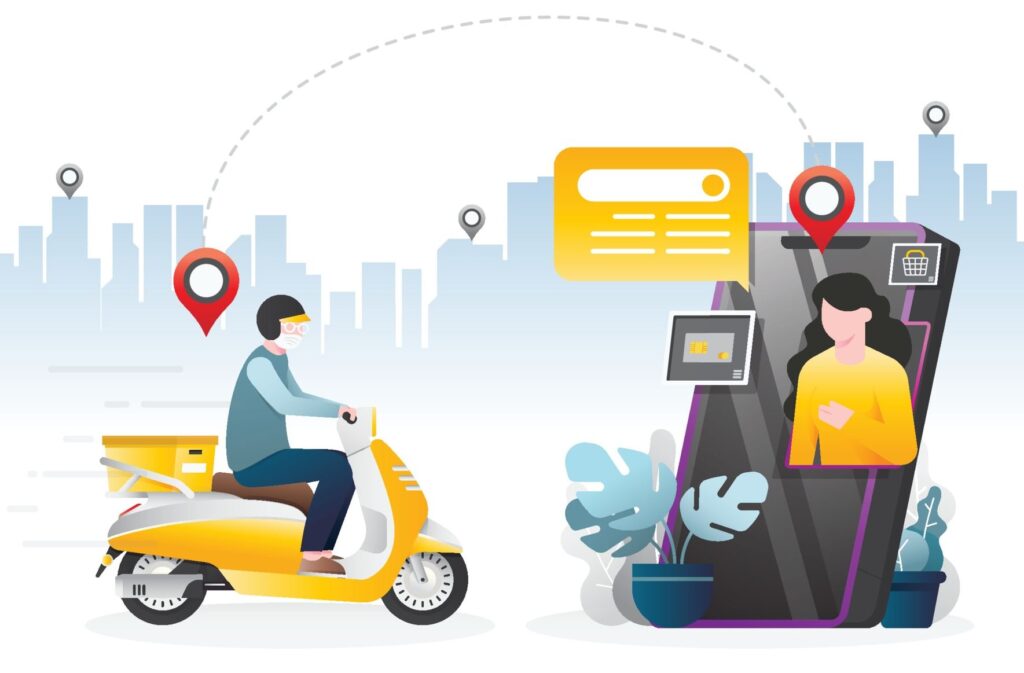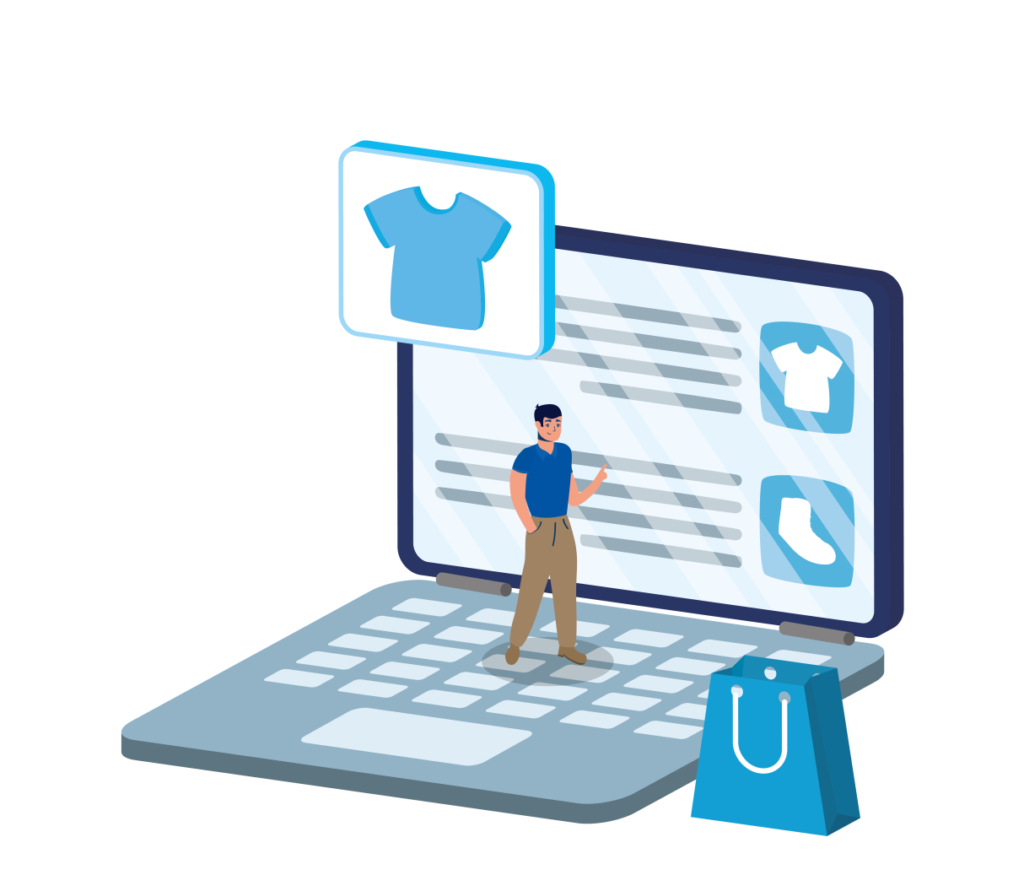Ecommerce Website Development: Comprehensive Guide
In today’s digital economy, ecommerce websites are the primary way for businesses to sell their products online. Even small businesses can now reach a global audience with an ecommerce website. An ecommerce website is necessary to sell your products online, but developing one isn’t easy. There are many challenges and considerations when creating an ecommerce website.
Table of content
Table of Contents
In today’s digital economy, ecommerce websites are the primary way for businesses to sell their products online. Even small businesses can now reach a global audience with an ecommerce website. An ecommerce website is necessary to sell your products online, but developing one isn’t easy. There are many challenges and considerations when creating an ecommerce website.

You need to consider things like search engine optimization (SEO), user experience (UX), hosting, payment gateways, shipping logistics, and much more. This Ecommerce Website Development Guide will answer all of your questions about creating an ecommerce website from start to finish. Let’s get started!
Guide to Ecommerce Website Development
Before diving into the details of ecommerce website development, let’s discuss why this needs to be part of your business strategy in the first place. The eCommerce industry is expected to grow to $27 trillion by 2026, making it one of the fastest growing industries in the world.
In addition, according to the 2017 State of B2B Marketing Report, B2B marketers who use eCommerce have seen a 54% increase in sales. That’s a big reason why many B2B businesses are making a point to build out their eCommerce strategy. Even though it’s growing, it’s important to note that eCommerce hasn’t reached 100% penetration yet.
In fact, only about 16% of the global retail sales come from eCommerce businesses. This means there’s plenty of opportunity for you to get in on the action. Ecommerce website development is one of the best ways to get your products in front of potential customers.
Defining Your Ecommerce Website Requirements
Before you begin building out your ecommerce website, you need to first define your requirements. This includes the types of products you want to sell, who your target audience is, and the pricing plan you’ll use. Types of Products – Make a list of the products you want to sell, and then decide which ones you want to prioritize.
While you may want to sell everything, you may not be able to because of inventory issues. For example, if you are a clothing retailer and want to sell swimsuits, you’ll want to pay attention to the seasons to make sure you have enough inventory.
Who is your Audience – You may think you know who your customer is, but do you really? Creating a persona will help you to better understand your customer so you can cater your ecommerce website to their needs. Pricing Plan – Make note of the pricing plan you’d like to use. If you decide to use a subscription model, keep in mind that you’ll have to design your ecommerce website to be subscription-friendly.
Finding the Right Ecommerce Platform
Now that you’ve defined the requirements for your ecommerce website, it’s time to find a platform that’s right for you. Here are a few things to keep in mind while you’re looking:
- What is your budget? Ecommerce development platforms don’t come cheap, so make sure you have a budget in mind before you begin shopping around.
- What are your business goals? Your ecommerce goals will determine which platform you should use. If you want to sell to a global audience, you’ll need to select a platform that offers multiple language support.
- What are your website goals? Think about how your website will function, and look for platforms that will let you achieve your goals.
- What is your audience like? If you’re selling a product to children, you’ll want to look for an ecommerce platform that is child-friendly. If your customers are older, you might want to avoid platforms that have a younger feel. Now that we know what to look for when searching for an ecommerce platform, let’s take a look at some of the most popular ecommerce platforms on the market:
- Shopify – Shopify is a fully-hosted ecommerce platform that comes with a 14-day free trial. It offers you everything you need to get your ecommerce store up and running quickly and easily, including payment processing, shipping, and more.
- BigCommerce – BigCommerce is another fully-hosted ecommerce platform that offers a 14-day free trial. This is an ecommerce platform that’s best for businesses that sell in specific industries, like health and beauty, retail, or travel.
- Magento – Magento is a platform that’s highly customizable and scalable, but it can also be difficult to setup. You’ll need to hire a developer to get everything set up correctly, which can be costly.

Ecommerce Development Process
Now that you know what to look for in an ecommerce platform, it’s time to start building your ecommerce website. Here’s how the process works:
- Planning – This includes deciding what your website will look like, what your business goals are, and how your website will function. You’ll need to put together an ecommerce strategy, decide how you’ll market your ecommerce website, and more.
- Getting your website designed – You can either outsource this task to a design team or you can hire a developer who can design your website for you. If you decide to hire a team, make sure they understand your requirements and that they use the right ecommerce website frameworks.
- Getting your website hosted – Make sure you choose a hosting provider that offers ecommerce hosting. The hosting provider should have robust bandwidth and a 99% uptime guarantee, along with a reliable support team.
- Getting an ecommerce payment gateway – You’ll need one of these to accept payments on your website. Make sure the payment gateway you choose is PCI compliant, so you don’t have to worry about getting hacked.
- Getting your logistics in order – You’ll need to make sure your supply chain is ready to go when your ecommerce development website goes live. If you’re selling physical products, you’ll need to make sure you have a way to get those products to your customers.
- Launching your ecommerce website – Once everything is ready, you can launch your ecommerce website and start bringing in customers and making sales.
Resources for Finding the Right eCommerce Partner
Now that you know how the ecommerce website development process works, let’s talk about how to find the right ecommerce partner. Finding the right ecommerce partner is important, since they’re responsible for designing and building your ecommerce website. Here’s what you should do to find the right ecommerce partner:
- Define your requirements – Start by listing out the requirements your ideal ecommerce partner would have. These requirements will help you weed out the bad partners and focus on the ones that fit your needs.
- Find potential partners – Next, find potential partners and learn more about them. You can do this by searching for ecommerce companies in your area and reaching out to them. You can also find potential partners by attending ecommerce conferences and networking with people in the industry.
- Outline your requirements – Once you’ve found a few potential partners, outline your requirements and send them their way. Make sure to include the price range you’re looking to spend on the project.
- Select the right partner – Now that you’ve narrowed down your options, it’s time to select the right partner. You can do this by meeting with the companies and asking them any questions you have. Make sure to pick the partner that best fits your needs.
How much does it cost to start an ecommerce business?
The cost of starting an ecommerce business will depend on the type of product or service you choose to sell, your overhead cost, and your marketing budget. If you’re wondering how much it costs to start an ecommerce business, you should consider your upfront costs as well as your ongoing expenses.
The upfront cost to start an ecommerce business will include things like purchasing inventory, hiring staff, and paying for legal and accounting services. Depending on the type of product you decide to sell, you may also need to invest in inventory, shipping, and other logistics.
The ongoing costs of operating an ecommerce business include things like web hosting, customer service, and product research and development. Once you launch your ecommerce business, you’ll also need to factor in marketing expenses, like hiring a PR or social media consultant.
Research and determine your niche
Choosing a niche for your ecommerce business can be both exciting and challenging. While you’re excited about the prospect of making money, selecting a niche can be difficult.
To start your research, you can use an ecommerce business niche tool, like the one offered by Shopify, or you can conduct your own research. While finding a niche that is profitable and in demand is important, it’s also important to identify a niche that you truly enjoy. If you don’t enjoy your niche, it will be difficult to succeed. You may also want to consider finding a niche that is currently underserved.
If you can find a niche with low competition, you have a greater chance of success. Your research should ultimately lead you to a niche that you’re passionate about, that has the potential for growth, and that you have the skills and resources necessary to successfully tackle.
Create your product listing
Creating your product listing is critical for a number of reasons. A high-quality product listing will not only encourage people to visit your website, but it will also help you boost your SEO rankings. Because Google favours product listings, a company will entice readers if it creates a product listing through the use of a computer or a laptop.
Every product listing should include a title, a description of the product, its variations, a customer review, and a call-to-action. Your product listing is a superb place to link to your social media accounts. While you do not want to overlink to various platforms, a few strategic connections may go a long way towards boosting your brand recognition.
Promote your ecommerce business
Creating your ecommerce business is just the first step in turning it into a profitable venture. You also need to promote your ecommerce business. There are a number of different ways you can promote your ecommerce business.
Creating an email list – The best way to reach your customers consistently is through email. Email is a low-cost marketing tool that you can use to share your latest products, run promotions, and reach out to your customers.
- Social media – Social media can be a great way to build your ecommerce brand, provided you know how to use it properly. While it’s easy to share links to your products on social media, it’s important to know how to use each platform and avoid the mistakes that can turn your followers off.
- Email marketing – Email marketing can be an excellent way to reach your customers and build your brand, provided you don’t spam your subscribers.
- Regular blog posts – Regular blog posts are an excellent way to build brand awareness and keep your customers engaged.
Rich Content ads
Rich content ads have been gaining traction as a form of advertisements in recent years. Many large eCommerce development companies have adopted rich ads as a new way to advertise their products to customers. Rich ads allow you to include images, videos, and more, all within the desktop or mobile advertisement.
There can also be links to your website or social media platforms to encourage more engagement. There are many different types of rich ads that you can use, depending on what type of products you are selling. You can include rich media for apparel, travel, food, or pretty much any other product type.
Rich ads are effective as they are tailored to each customer, so they are more likely to engage with the advertisement and click the link. This can lead to more conversions and sales for your business. Rich ads are great for eCommerce companies because they are highly customizable and allow you to include any information that is relevant to the product you are selling.

Artificial Intelligence
Artificial intelligence is one of the most exciting new technologies out there. AI is when a computer program is able to understand and apply new information based on previous knowledge. AI is not new to eCommerce, but it is gaining traction as a more practical and useful solution for businesses. If you have a customer service chatbot that is powered by artificial intelligence, it will be able to learn from each interaction and apply the information to future customers.
This allows the chatbot to become more intelligent with each interaction, and more likely to provide the most helpful answer for each individual customer. An eCommerce development AI tool can be used to organize your inventory and product information, provide personalized recommendations based on purchases in the past, and more. AI is a very useful technology that can greatly benefit eCommerce businesses.
3D Visualization
3D visualization is a great way to showcase your products in a very realistic and lifelike way. This is great for high-end luxury items or products that need a bit more explanation or representation. 3D visualization provides a realistic experience without actually having to physically hold or touch the product.
This allows customers to see the item in the way that you see it, which can be helpful when trying to sell higher-end products that need a bit more explanation. It can be helpful to include 3D visualization for any type of product that could benefit from a more realistic representation. This includes items like furniture, kitchen items, and more.
Voice recognition and automation
In recent years, voice recognition and automation technologies have become increasingly popular. Voice recognition is a computer program that recognises and interprets your voice commands. This allows you to operate your eCommerce development platform or other computer programmes using just your voice. Automation refers to a computer programme performing a certain job automatically. For example, an eCommerce automation programme may automatically send order notifications to your customers or inventory updates to your suppliers.
You can also set up specific computer programs to perform tasks automatically based on certain criteria. For example, your computer program may be set up to automatically re-stock your most popular items when they fall below a certain threshold. This allows you to maintain a more efficient business while also saving time and money.
Omnichannel strategies
If you haven’t already heard about omnichannel strategies, you’ve likely heard the term floating around. Omnichannel is when retailers provide seamless shopping experiences across multiple channels – including in-store, online, and through customer service interactions. For example, a retailer may allow customers to order their products online and then pick up their purchase at their local store.
This gives customers the option to order online or in-store and also allows them to return their order to a local store without needing to ship it back. This seamless shopping experience is great for customers, and it allows retailers to provide a better experience while also increasing sales. Creating an omnichannel strategy is a great way to provide a seamless experience while incorporating custom eCommerce development technologies. You can use these technologies to provide a better shopping experience while also offering more options for your customers.
B2B platform integration
An B2B eCommerce platform allows companies to sell their goods to one another rather than to consumers. B2B eCommerce platforms are often utilised in industries such as pharmaceuticals, government, and much more. B2B eCommerce platforms can utilise several custom technologies such as inventory management and order tracking.
An eCommerce platform is a great way for companies to sell their products to other businesses. An eCommerce platform can allow businesses to sell their products, manage their inventory, and more. Integrating your eCommerce platform with other B2B eCommerce development platforms can be a great way to expand your product offerings and gain new customers while also saving time and money.

Chatbots and AI tools
Chatbots are computer programs designed to have conversations with customers via text or voice. A customer may be able to reach out to your company to ask a question or inquire about a product, and they will be able to do so through a computer program. A popular use of chatbots is in customer service.
You can set up your computer program to respond to questions about your products, shipping information, and more. A chatbot can be a great way to offer excellent customer service while also cutting down on the amount of time that employees need to spend on these interactions.
Ecommerce Marketing
In today’s online world, there are many different ways to market your ecommerce business. Some of these methods might seem a bit strange or perhaps even a little outdated, but they all have the potential to help you drive traffic to your website and ultimately increase sales.
Even though there is so much competition in the ecommerce space right now, it’s still possible for you to stand out from the pack if you know how to market your business effectively. There are plenty of covers on how to optimize your ecommerce site and where to get keywords ranked on search engines, but not enough detailed guides on effective marketing strategies that will get more people buying from you and not your competition.
Paid Marketing Strategies
The most common marketing method used by ecommerce businesses is paid marketing. If you want to get more customers in a short period of time, paid advertising is your best option. Here are some of the most popular paid marketing strategies.
- Banner Ads – These are the most common type of paid marketing on the internet. You can place banner ads on other websites or run them on your own website, or even on social media platforms like Facebook and Instagram.
- Retargeting Ads – Retargeting ads are a type of paid marketing where the ads follow people around online after they’ve visited your website by showing them ads for your products in their social media feeds and on other websites.
- Paid Search (Google Ads) – This is how ecommerce businesses can get their products ranked high on Google to drive more organic traffic and sales.
- Paid Social Media – This is a great way to get your ecommerce business in front of more people, but it can be really tricky to get it right and not get banned from the platforms you’re advertising on.
Free Marketing Strategies
Free marketing is an often-overlooked but highly effective strategy for building an ecommerce business. The key here is to create quality content that your customers will find useful and then share it on social media to drive traffic to your store. Here are some of the most popular free marketing strategies.
- Create Great Content – It might sound obvious, but creating great content with useful information is the first step to getting people to share your website and ecommerce store. Some ideas for content include product reviews, tips, DIY projects, and more.
- Build Communities – It’s not enough to have a website that people visit once and forget about. You should be creating a community around your ecommerce brand that people feel a part of. This could be a blog with a dedicated readership, a social media presence on Facebook and Instagram, or even a Discord server.
- Make Friends With Influencers – It’s easier than ever to reach out to people with large followings and pitch them to get them to share your content and encourage their followers to visit your website.

Email Marketing Strategies
Email marketing is a powerful way to engage your current customers and also get new ones on board. The best way to do this is to create an email list where you can engage with your customers on a regular basis and build a relationship with them. Here are some of the most common email marketing strategies.
- Include An Opt-In Pop-Up – A pop-up on your website is one of the best ways to get people to sign up for your email list and make it easy for them to do so. There are lots of different pop-up plugins you can use for this.
- Send Regular Emails – Once you have a list of subscribers, you need to send them regular emails to stay in touch and keep them engaged. Having regular content in these emails can also help you rank higher in search results.
- Offer Frequency-Based Rewards – One of the best ways to get people engaged with your emails is to offer them rewards for signing up. This could be a discount code, free e-book, or access to useful content.
Influencer Marketing Strategies
If you have a large enough budget, you can reach out to influencers to promote your ecommerce business and drive a ton of traffic to your site. The best way to do this is to find relevant influencers in your niche and reach out to them to see if they would be interested in collaborating and promoting your products in exchange for a fee. Here are some of the most common influencer marketing strategies.
- Find Relevant Influencers – The first step in influencer marketing is to find relevant influencers who are in your niche. You can use sites like BuzzSumo and NinjaOutreach to find these people.
- Reach Out And Build A Relationship – Once you’ve found some influencers, the next step is to reach out to them and build a relationship. It’s best to do this over email because you can send them all the information about your products and offer at once.
Website Rebuilding Strategies
If you want to try something new and drastic, you can choose to rebuild your current ecommerce website or create a new one from scratch. Rebuilding your site can be an expensive and time-consuming process, but it can also yield results. Here are some of the most common website rebuilding strategies.
- Create A New Brand – If you want to try something drastic, the best option might be to completely start over and create a new brand. This could mean starting a new business and completely abandoning your current ecommerce site. Alternatively, you could try to rebrand your current site and change its focus.
- Create New Landing Pages – Another strategy you can try is to rebuild your current ecommerce site and create new landing pages. This is a more middle-of-the-road approach that still has the potential to be effective.
Marketing your ecommerce business can be challenging but it’s something you have to do if you want to be successful. There are many different options when it comes to marketing, but what works for one business might not work for another. It’s important to identify which marketing strategies work best for your ecommerce store and then put in the work to make them successful.


